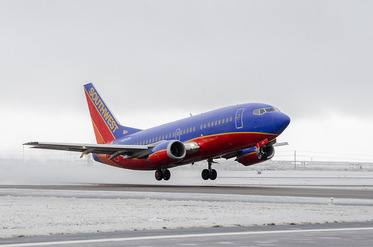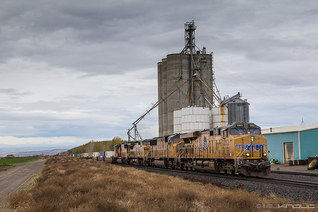Transportation Infrastructure
"The Permian Basin has and continues to make a significant contribution to this state (Texas). We are committed to working with state, regional, and local officials to finding the funding streams necessary to ensure that those of us in these energy producing areas can meet our needs, both for today and the future"
- MOTRAN Chairman J.D. Faircloth
The Permian Basin region boasts a mature and robust transportation infrastructure comprised of a strong network of Interstate and State Highways, rail lines, airports, and the Midland Space Port. The region's mature infrastructure sets it apart from other regions, particularly those heavily invested in oil and gas exploration such as the Eagle Ford Shale in south Texas. The transportation infrastructure, however, has been taxed and capacity has been tested as the latest energy boom has increased heavy truck traffic on state and local roadways to unprecedented levels, particularly as it involves natural gas production.
The increase in traffic has compromised the condition of regional roadways, particularly city and county roadways, and challenged local governments to maintain road conditions and ensure public safety. Local municipal and county governments have responded accordingly, but the rapid deterioration of roadways, significant capital requirements, and limited construction capacity have proven to be significant challenges. In addition, the region's rail system has required significant investment to ensure sufficient capacity and access (rail spurs) to support energy production, manufacturing, and distribution industry growth.
Passenger and cargo air transportation reached all time highs at Midland International Air and Space Port in 2014, indicative of a regional increase that has impacted air fields from Midland International, to smaller municipal airstrips in the region. While communities have made significant investment in air fields in recent years to improve capacity, continued sustained investment is needed to accommodate increase oil and gas production and industrial diversification, including the emergence of a high-tech Space Port cluster.
Rail, likewise, is being taxed at unprecedented levels with the recent oil and gas boom cycle. Rail capacity has improved significantly in recent years as private and public investments have increase rail lines, spurs, transloading facilities, etc., but capacity is frequently cited as an impediment to continued economic development. New investments to improve capacity and access will be required to supply the demand for movement of goods in and out of the Permian Basin region, particularly as fracking practices increase and diversification into manufacturing and transportation/logistics takes hold.
Below is a discussion of the strong advocacy assets of the region, and an overview of the existing transportation infrastructure.
The increase in traffic has compromised the condition of regional roadways, particularly city and county roadways, and challenged local governments to maintain road conditions and ensure public safety. Local municipal and county governments have responded accordingly, but the rapid deterioration of roadways, significant capital requirements, and limited construction capacity have proven to be significant challenges. In addition, the region's rail system has required significant investment to ensure sufficient capacity and access (rail spurs) to support energy production, manufacturing, and distribution industry growth.
Passenger and cargo air transportation reached all time highs at Midland International Air and Space Port in 2014, indicative of a regional increase that has impacted air fields from Midland International, to smaller municipal airstrips in the region. While communities have made significant investment in air fields in recent years to improve capacity, continued sustained investment is needed to accommodate increase oil and gas production and industrial diversification, including the emergence of a high-tech Space Port cluster.
Rail, likewise, is being taxed at unprecedented levels with the recent oil and gas boom cycle. Rail capacity has improved significantly in recent years as private and public investments have increase rail lines, spurs, transloading facilities, etc., but capacity is frequently cited as an impediment to continued economic development. New investments to improve capacity and access will be required to supply the demand for movement of goods in and out of the Permian Basin region, particularly as fracking practices increase and diversification into manufacturing and transportation/logistics takes hold.
Below is a discussion of the strong advocacy assets of the region, and an overview of the existing transportation infrastructure.
Advocacy
Improvements to transportation infrastructure in the region are supported by two influential advocacy groups, the MOTRAN Alliance and the Ports To Plains Alliance.
MOTRAN Alliance:
The MOTRAN Alliance has worked jointly with the Departments of Economic Development of the States of Chihuahua, Sinaloa and Durango to plan and develop La Entrada Al Pacifico (The Entrance to the Pacific), a trade corridor to the Pacific.
The Corridor is a state and federally designated trade corridor from Texas to Chihuahua City in Mexico, and continuing to the Mexican Port of Topolobamp in the Mexican state of Sinaloa. Chihuahua is one of the four largest trading partner states with the United states, and this new corridor will capture a majority of this trade for Texas. Long term, after the completion of a highway from Chihuahua City to Topolobampo, and improvements of rail facilities, it will offer Texas with long-term access to a Pacific deep water port that is approximately 500 miles closer and much less expensive than the Port of Los Angeles.
Ports To Plains Alliance:
The Ports-to-Plains Alliance, headquartered in Lubbock, is a non-profit, non-partisan, community-driven advocacy group led by local elected officials, economic development and chambers of commerce executives, and other business and regional leaders representing communities throughout the ten US States encompassed by the Ports-to-Plains corridor, as well as in Canada and Mexico.
Over the past decade, Ports-to-Plains Alliance members have raised over U.S. $1.2 billion in federal funding for road expansion improvements in the ten-state Ports-to-Plains Alliance region and continuously advocate and seek innovative ideas to secure additional funding for future development of the corridor. Members of the Alliance collaborate with federal and state leaders, partners in Canada and Mexico, and industry partners, to deliver the infrastructure, food, fiber, and fuel to secure the quality of life throughout America’s great cities.
MOTRAN Alliance:
The MOTRAN Alliance has worked jointly with the Departments of Economic Development of the States of Chihuahua, Sinaloa and Durango to plan and develop La Entrada Al Pacifico (The Entrance to the Pacific), a trade corridor to the Pacific.
The Corridor is a state and federally designated trade corridor from Texas to Chihuahua City in Mexico, and continuing to the Mexican Port of Topolobamp in the Mexican state of Sinaloa. Chihuahua is one of the four largest trading partner states with the United states, and this new corridor will capture a majority of this trade for Texas. Long term, after the completion of a highway from Chihuahua City to Topolobampo, and improvements of rail facilities, it will offer Texas with long-term access to a Pacific deep water port that is approximately 500 miles closer and much less expensive than the Port of Los Angeles.
Ports To Plains Alliance:
The Ports-to-Plains Alliance, headquartered in Lubbock, is a non-profit, non-partisan, community-driven advocacy group led by local elected officials, economic development and chambers of commerce executives, and other business and regional leaders representing communities throughout the ten US States encompassed by the Ports-to-Plains corridor, as well as in Canada and Mexico.
Over the past decade, Ports-to-Plains Alliance members have raised over U.S. $1.2 billion in federal funding for road expansion improvements in the ten-state Ports-to-Plains Alliance region and continuously advocate and seek innovative ideas to secure additional funding for future development of the corridor. Members of the Alliance collaborate with federal and state leaders, partners in Canada and Mexico, and industry partners, to deliver the infrastructure, food, fiber, and fuel to secure the quality of life throughout America’s great cities.
Planning
MOTOR MPO is responsible for long-range transportation planning in a defined area known as the Metropolitan Area Boundary (MAB). The MAB is a geographic area determined by agreement between local MPO and the Governor in which the metropolitan transportation planning process is carried out (23 CFR 450). The MOTOR MPO MAB includes most of the incorporated land within the City of Midland, all of the City of Odessa, and portions of both Midland and Ector Counties.
Interstate and Highway System

Interstate Highways 10 and 20 bisect running east-west, connecting the Permian Basin to El Paso, Dallas-Fort Worth, and San Antonio. The region also boasts a major north-south connection to Lubbock and Amarillo in HWY 87/IH 27, which connects to IH-40. In addition to significant Interstate Highway presence, the region boasts a strong network of State Highways, County and Local Roadways that are significant economic assets for the region.
Texas Department of Transportation (TXDOT) has more than $266 million in active and planned projects to improve the region's state highways in the Odessa District. 26 of 43 total projects are in Midland and Ector Counties. Pecos and Reeves both have 5 funded projects.
Texas Department of Transportation (TXDOT) has more than $266 million in active and planned projects to improve the region's state highways in the Odessa District. 26 of 43 total projects are in Midland and Ector Counties. Pecos and Reeves both have 5 funded projects.
Rail
|
The Permian Basin rail system is comprised of east-west Union Pacific Railroad Company and Texas Pacifico Transportation Limited railways as well as north-south Burlington Northern Santa Fe Corporation railways. This dynamic allows for the efficient import and distribution of materials and goods from the region providing an important economic advantage for companies with a footprint in the region.
The Union Pacific Railroad line passes through Howard, Martin, Midland, Ector, Ward, Terrell, and Reeves counties, parallel in most areas to I-20 and I-10. The Texas Pacifico Transportation Limited Railroad passes through Upton and Pecos counties. Permian Basin Railways serves Gaines, Ward and Winkler counties. The Texas New Mexico Railroad operates a freight service from a connection with Union Pacific at Monahans to Lovington, New Mexico. The Union Pacific Railroad and the Agri-Empresa Transloading facility have connected the region to the major metro areas of the Central and Western United States. |
Airports

The airport infrastructure for the Permian Basin region is anchored by the Midland International Air and Space Port, a 1600 acre municipally owned airport located approximately midway between Midland and Odessa that serves more than 900,000 passengers annually. One of eight FAA licensed commercial spaceports, Midland International is the first primary commercial service airport certified by the FAA as a spaceport.
The Midland Executive Airpark is operated by the City of Midland and serves the general aviation public, including personal and business/corporate traffic.
The region also boasts a strong network of regional airports used both commercially and privately to transport people and goods. Regional Airports include:
- McMahon Wrinkle Airport, Big Spring (BPG), former home of Webb Air Force Base, boasts 8800' by 100' and 4400' by 75' runways (capable of landing 737 type aircrafts and smaller planes) and is serviced by major freight carriers.
- Andrews County Airport has runways of 5815', 3048', and 2935'.
- Lamesa Municipal Airport boasts a 5000'. paved runway with fueling station.
- Stanton Municipal Airport has a 4240' runway.
- Fort Stockton Pecos County Airport
- Upton County Airport
- Roy Hurd Memorial Airport (Monahans)
- Odessa Schlemeyer Field
- Pecos Municipal Airport
- Gaines County Airport
- Winkler County Airport
- Crane County Airport
- Iraan Municipal Airpark
- Dryden International (Terrell County) Airport provides a 4500' runway, fixed base operator, and fuel.
- SkyWest Inc., Midland
The Midland Executive Airpark is operated by the City of Midland and serves the general aviation public, including personal and business/corporate traffic.
The region also boasts a strong network of regional airports used both commercially and privately to transport people and goods. Regional Airports include:
- McMahon Wrinkle Airport, Big Spring (BPG), former home of Webb Air Force Base, boasts 8800' by 100' and 4400' by 75' runways (capable of landing 737 type aircrafts and smaller planes) and is serviced by major freight carriers.
- Andrews County Airport has runways of 5815', 3048', and 2935'.
- Lamesa Municipal Airport boasts a 5000'. paved runway with fueling station.
- Stanton Municipal Airport has a 4240' runway.
- Fort Stockton Pecos County Airport
- Upton County Airport
- Roy Hurd Memorial Airport (Monahans)
- Odessa Schlemeyer Field
- Pecos Municipal Airport
- Gaines County Airport
- Winkler County Airport
- Crane County Airport
- Iraan Municipal Airpark
- Dryden International (Terrell County) Airport provides a 4500' runway, fixed base operator, and fuel.
- SkyWest Inc., Midland
Public Transportation
Public transportation is available on a limited scale within the Permian Basin.
West Texas Opportunities, Inc. (WTO,I) provides transportation to the Permian Basin region through several targeted public transit programs.
The 5311 Public Transportation program, commonly known as TRAX, provides professional, cost effective, coordinated passenger transportation services to the general public in the non-urbanized areas of Texas using the most efficient combination of financial and other resources. The WTO,I governing board administers this non-profit entity known as the Permian Basin Rural Transit District, established in 2003 by the Permian Basin Regional Planning Commission, and recognized as a political subdivision of the state. In 2010 TRAX subcontracted with West Side Day Care Center in Big Spring, Dawson County Senior Citizen Center, and with Big Bend Community Action Committee.
This 5310 Division of Public Transportation funds improvements in accessibility and mobility for the elderly and for individuals with disabilities. During 2010 the 5310 program provided 13,544 trips. WTO,I subcontracted with North Side Senior Center in Odessa, Terrell County, Martin County Senior Center, Rankin Senior Citizen Services, Inc. and Pecos Senior Center.
The Medical Transportation Program (MTP) provides transportation to medical facilities for Medicaid recipients.
WTO,I provides this service for the entire 17-county Permian Basin Region (Andrews / Borden / Crane / Dawson / Ector / Gaines / Classcock / Howard / Loving / Martin / Midland / Pecos / Reeves / Terrell / Upton / Ward / Winkler). During 2010 there were 60,615 MTP trips provided. WTO,I subcontracted with Midessa Transportation to provide medical transportation service to Midland and Ector counties.
EZ Rider (Midland/Odessa Urban Transit District) is the public transportation provider in Midland and Odessa, and provides fixed-route bus service and ADA curb-to-curb service within the urbanized areas of both cities. EZ Rider serves Ector and Midland Counties.
Ector County Senior Center (ECSC) serves Ector County.
Community & Senior Services of Midland (CCSM) serves Midland County
Pecos County Community Action Agency (PCCAA) serves Pecos County
Terrell County Senior Citizen's Transportation Program (TCSCTP) serves Terrell County
West Texas Opportunities, Inc. (WTO,I) provides transportation to the Permian Basin region through several targeted public transit programs.
The 5311 Public Transportation program, commonly known as TRAX, provides professional, cost effective, coordinated passenger transportation services to the general public in the non-urbanized areas of Texas using the most efficient combination of financial and other resources. The WTO,I governing board administers this non-profit entity known as the Permian Basin Rural Transit District, established in 2003 by the Permian Basin Regional Planning Commission, and recognized as a political subdivision of the state. In 2010 TRAX subcontracted with West Side Day Care Center in Big Spring, Dawson County Senior Citizen Center, and with Big Bend Community Action Committee.
This 5310 Division of Public Transportation funds improvements in accessibility and mobility for the elderly and for individuals with disabilities. During 2010 the 5310 program provided 13,544 trips. WTO,I subcontracted with North Side Senior Center in Odessa, Terrell County, Martin County Senior Center, Rankin Senior Citizen Services, Inc. and Pecos Senior Center.
The Medical Transportation Program (MTP) provides transportation to medical facilities for Medicaid recipients.
WTO,I provides this service for the entire 17-county Permian Basin Region (Andrews / Borden / Crane / Dawson / Ector / Gaines / Classcock / Howard / Loving / Martin / Midland / Pecos / Reeves / Terrell / Upton / Ward / Winkler). During 2010 there were 60,615 MTP trips provided. WTO,I subcontracted with Midessa Transportation to provide medical transportation service to Midland and Ector counties.
EZ Rider (Midland/Odessa Urban Transit District) is the public transportation provider in Midland and Odessa, and provides fixed-route bus service and ADA curb-to-curb service within the urbanized areas of both cities. EZ Rider serves Ector and Midland Counties.
Ector County Senior Center (ECSC) serves Ector County.
Community & Senior Services of Midland (CCSM) serves Midland County
Pecos County Community Action Agency (PCCAA) serves Pecos County
Terrell County Senior Citizen's Transportation Program (TCSCTP) serves Terrell County
